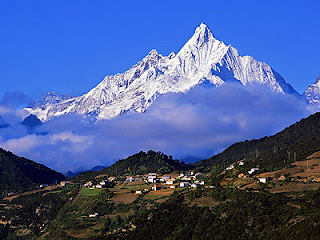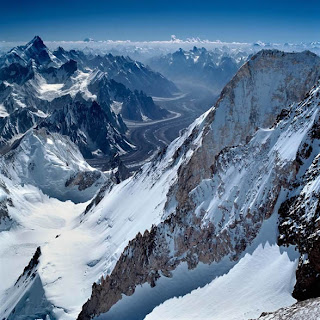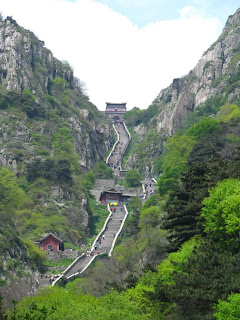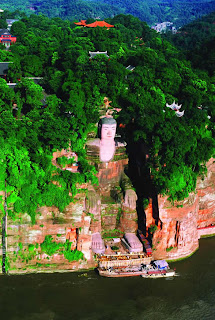China is one of the top tourist destinations not only because it possesses quite a number of magnificent structures that are famous all over the world but it also boasts breathtaking landscapes and picturesque locations brought by its geographical setting. Located in East Asia, it is the world’s second-largest country by land area covering an approximately 9.6 kilometers or 3.7 million square miles.
China’s landscape is vast and diverse, with forest steeps and deserts occupying the arid north and northwest. Subtropical forests are more prevalent in the wetter south while the terrain of western China is rugged and elevated. The Himalaya, Karakoram, Pamir and Tian Shan mountain ranges separate China from the boarder of Central Asia. The world’s highest mountain, Mt.Everest and the second-highest point, K2 also lie on China’s borders that is why it is not surprising that many tourists book airfare to China to admire and explore the beauty of its mountains. Here are the famous mountains in China where one could find peace and tranquility amidst its lush surroundings and enchanting sceneries.
 First on the list is the Namiagbarwa Peak which is located in Nyingchi Region of Tibet Autonomous Region. Surrounded by clouds and mists, snuggled by the river and valley and clustered round by forest, Namjagbarwa is appraised as the most beautiful mountain in China by a number of scientists, explorers and climbers.
First on the list is the Namiagbarwa Peak which is located in Nyingchi Region of Tibet Autonomous Region. Surrounded by clouds and mists, snuggled by the river and valley and clustered round by forest, Namjagbarwa is appraised as the most beautiful mountain in China by a number of scientists, explorers and climbers.With a height of 25,531 feet (7,782 meters) above sea level, Namjagbarwa is considered as the fifteenth highest peak in the world. From the top down to the bottom, in a linear distance of 6,562 feet (2 kilometers), scenes on the Namjagbarwa vary from snowy winter to evergreen season. On the top, snow persists throughout the year. Beneath the snow-line, there are dark green alpine plants. Further down, clumps of bushes begin to appear. Mauve azaleas in full bloom and pink primroses adorn the mountainside and large tracts of tall firs form a frigid taiga forest. In the lower edge of the taiga forest, you can see trees with larger leaves. Camphor trees which are abundant are emitting a unique fragrance giving the area its distinct smell. At the lower venue, forests become denser. You can see bananas and other tropical plants swaying their huge leaves. The atmosphere is full of the specific muggy air of tropical rain forest. How magical Namjagbarwa is! Because of great altitude, it has become such a good magician that varied sights can be in one same picture. No wonder Namjagbarwa is called a world natural museum of mountain vegetation forms.
 The snow-capped sceneries in the Mountain Gongga also known as Minya Konka in Ganzi Tibetan Autonomous Prefecture of Sichuan province will surely take every tourist’s breath away. “Gong” in Tibetan’s language means permanent snow cover while “Ga” means white, so Gongga translates to ‘white snow cover’. Its peak rises to a 7556 meters, making it the highest peak east of the Himalayas, and the highest mountain in Sichuan Province. Minya Konka peak can be best described as a high snowy peak with narrow ridges because the snow in this mountain does not melt perennially. While wildlife on the grasslands has been deeply affected by the changes in Tibet, remote mountain peaks and valleys often serve as refuges of isolation where wildlife remains abundant. The climate of Minya Konka is moist, snowy and very unpredictable. Climbing this snowy mountain is said to be more difficult than Mt. Everest. In fact it’s been recorded that since 1932, only seven expeditions, with 22 people, have reached the summit of Minya Konka successfully.
The snow-capped sceneries in the Mountain Gongga also known as Minya Konka in Ganzi Tibetan Autonomous Prefecture of Sichuan province will surely take every tourist’s breath away. “Gong” in Tibetan’s language means permanent snow cover while “Ga” means white, so Gongga translates to ‘white snow cover’. Its peak rises to a 7556 meters, making it the highest peak east of the Himalayas, and the highest mountain in Sichuan Province. Minya Konka peak can be best described as a high snowy peak with narrow ridges because the snow in this mountain does not melt perennially. While wildlife on the grasslands has been deeply affected by the changes in Tibet, remote mountain peaks and valleys often serve as refuges of isolation where wildlife remains abundant. The climate of Minya Konka is moist, snowy and very unpredictable. Climbing this snowy mountain is said to be more difficult than Mt. Everest. In fact it’s been recorded that since 1932, only seven expeditions, with 22 people, have reached the summit of Minya Konka successfully. The subject of many expeditions wherein some became the material for films, Mt.Everest also known as Mount Qomolangma is perhaps the most famous mountain in the world. Having the highest peak in the world, it has been called the most revered of all mountains and the world's third pole. Mt.Qomolangma has a height of 8,844.43 meters above sea level. Its northern slope is in Tingri County, Tibet, China and its southern slope lies within Nepal. It is a surrounded by towering mountains for a radius of 20 kilometers, more than 40 of them over 7,000 meters high. They include the famous Lhotse (the world's 4th highest peak) and Makalu (the world's 5th highest peak) to the southeast. Mt.Everest depicts a picture of a huge pyramid, mighty and imposing. Its surrounding landforms are very steep and dangerous, making its ascent very difficult even for the most experienced climbers.
The subject of many expeditions wherein some became the material for films, Mt.Everest also known as Mount Qomolangma is perhaps the most famous mountain in the world. Having the highest peak in the world, it has been called the most revered of all mountains and the world's third pole. Mt.Qomolangma has a height of 8,844.43 meters above sea level. Its northern slope is in Tingri County, Tibet, China and its southern slope lies within Nepal. It is a surrounded by towering mountains for a radius of 20 kilometers, more than 40 of them over 7,000 meters high. They include the famous Lhotse (the world's 4th highest peak) and Makalu (the world's 5th highest peak) to the southeast. Mt.Everest depicts a picture of a huge pyramid, mighty and imposing. Its surrounding landforms are very steep and dangerous, making its ascent very difficult even for the most experienced climbers. Experience the spiritual tranquility when you visit the Meili Snow Mountain which is the holy place of pilgrimage for Tibetan Buddhists and the first of the eight great divine mountains in the Tibetan region. Average elevation of 13 peaks amount to over 6000 meters in this particular location. The Kawagebo peak with 6740 meters high above the sea level is the highest one in Yunnan Province. Kawagebo in Tibetan is the God of Snow Mountain which is the sacred place for Buddhists. Nearby Kawagebo, 13 peaks line up, like a guard of honor for the God. Devotees of Buddhism climb the mountain during the period of the end of autumn and the beginning of the winter to worship without thinking of how long the ways they have to go. It is a sight that will move you seeing them crawl their way to the high mountain gradually. Way back in October 1989, the tenth Panchen Lama, Great Master of Tibetan Buddhism, held a grand religious meeting in front of Kagebo Peak, and now a stone tablet and a pagoda stand there welcoming tourists. In addition, at the foot of it, there are continuous glaciers and cirques known as the Modern Glaciers in the low latitude.
Experience the spiritual tranquility when you visit the Meili Snow Mountain which is the holy place of pilgrimage for Tibetan Buddhists and the first of the eight great divine mountains in the Tibetan region. Average elevation of 13 peaks amount to over 6000 meters in this particular location. The Kawagebo peak with 6740 meters high above the sea level is the highest one in Yunnan Province. Kawagebo in Tibetan is the God of Snow Mountain which is the sacred place for Buddhists. Nearby Kawagebo, 13 peaks line up, like a guard of honor for the God. Devotees of Buddhism climb the mountain during the period of the end of autumn and the beginning of the winter to worship without thinking of how long the ways they have to go. It is a sight that will move you seeing them crawl their way to the high mountain gradually. Way back in October 1989, the tenth Panchen Lama, Great Master of Tibetan Buddhism, held a grand religious meeting in front of Kagebo Peak, and now a stone tablet and a pagoda stand there welcoming tourists. In addition, at the foot of it, there are continuous glaciers and cirques known as the Modern Glaciers in the low latitude.Climbing Meili is a very dangerous thing to do that is why it still possesses a “virgin peak”, which means that no one had ever reached its peak. The complex geology of the Hengduan Mountain and the ever-changing climate in the low-latitude snow mountains mean that the Meili are fraught with fatal dangers. Violent glacier movements have aggravated fissures in the mountain body still further, giving rise to suspended glaciers, hidden ice crevices, ice avalanches and snow avalanches.
 Characterized by its odd-shaped, grotesque rock formation, seas of clouds and crystal-clear hot springs, Mt.Huangshan in east China’s Anhui province is one of the country’s ten best-known scenic spots. In fact it was listed as one of the World Natural Wonder and Cultural Heritages back in 1990. This scenic landscape extends 40 kilometers from south to north and 30 kilometers from east to west, covering an area of 154 square kilometers with a crowd of peaks wherein 72 have names according to the shapes they resemble. The three major ones have names such as Lotus, Brightness Top and Celestial Capital, all of them with a height of 1,800 meters above sea level.
Characterized by its odd-shaped, grotesque rock formation, seas of clouds and crystal-clear hot springs, Mt.Huangshan in east China’s Anhui province is one of the country’s ten best-known scenic spots. In fact it was listed as one of the World Natural Wonder and Cultural Heritages back in 1990. This scenic landscape extends 40 kilometers from south to north and 30 kilometers from east to west, covering an area of 154 square kilometers with a crowd of peaks wherein 72 have names according to the shapes they resemble. The three major ones have names such as Lotus, Brightness Top and Celestial Capital, all of them with a height of 1,800 meters above sea level.The scene is spectacular especially when it is cloudy, the pinnacles loom in mists as if they were illusionary and the mountain becomes vibrant with majesty and splendor as the sun shines through. The most interesting characteristic of this mountain is the changing of appearance with the alteration of the seasons. In Mt. Huangshan, pines and rocks are intimately involved with each other. Almost every rock has a pine tree growing out of the crevice, and every tree has tortuous and gnarled roots and branches. The still sea of snow-white cloud can suddenly begin to roll and toss, rise or fall, gather or disperse while the peaks emerge and disappear in the clouds like isles in the ocean. Since the ancient times, it has been visited by tourists seeking to understand its mystery and admiring its exceptional beauty.
 From the meandering ranges of mountains in Daocheng County, emerge the three Sacred Mountains of Daocheng: Xiannari, Yangmaiyong and Xianuoduoji. These three sacred mountains have been a sacred place for Tibetan Buddhism since the ancient times. Xiannairi is the main peak of the three sacred mountains having an altitude of 6032 meters. It is considered as the first among Daocheng's high peaks. According to legend, it is the incarnation of the Buddhist Goddess of Mercy Guanyin or Avalokitesvara. It is has a vast slopes, gentle gradient, and a look depicting Great Buddha sitting in peace, graceful and poised. The south peak Yangmaiyong on the other hand has an altitude of 5958 meters, known as the Bodhisattva Manjusri. It is dignified and stately, gentle, quiet, noble and impeccable. It has a pyramid-as peak is the world's most beautiful snow mountain. Lastly Xianuoduoji, the east peak with an altitude of 5958m, means the Buddha with warriors' hands, possesses a feature which resembles a young man of strong character, tall and handsome who represents the god of elimination brutality In Buddhism. He is believed to be brave, gallant and always in high spirits wearing a brightly colored tiger skin around the hips, and a huge, fierce python circles his waist. At the foot of the three sacred mountains lie wide pastureland, crisscrossed by brooks and streams flowing gently into lakes. There are woods and bushes too, and waterfalls formed by melting ice and snow creating captivating scenes which will surely make the trip unforgettable.
From the meandering ranges of mountains in Daocheng County, emerge the three Sacred Mountains of Daocheng: Xiannari, Yangmaiyong and Xianuoduoji. These three sacred mountains have been a sacred place for Tibetan Buddhism since the ancient times. Xiannairi is the main peak of the three sacred mountains having an altitude of 6032 meters. It is considered as the first among Daocheng's high peaks. According to legend, it is the incarnation of the Buddhist Goddess of Mercy Guanyin or Avalokitesvara. It is has a vast slopes, gentle gradient, and a look depicting Great Buddha sitting in peace, graceful and poised. The south peak Yangmaiyong on the other hand has an altitude of 5958 meters, known as the Bodhisattva Manjusri. It is dignified and stately, gentle, quiet, noble and impeccable. It has a pyramid-as peak is the world's most beautiful snow mountain. Lastly Xianuoduoji, the east peak with an altitude of 5958m, means the Buddha with warriors' hands, possesses a feature which resembles a young man of strong character, tall and handsome who represents the god of elimination brutality In Buddhism. He is believed to be brave, gallant and always in high spirits wearing a brightly colored tiger skin around the hips, and a huge, fierce python circles his waist. At the foot of the three sacred mountains lie wide pastureland, crisscrossed by brooks and streams flowing gently into lakes. There are woods and bushes too, and waterfalls formed by melting ice and snow creating captivating scenes which will surely make the trip unforgettable. Chogori Peak, better known as K2 has an altitude of 8,600 meters towering over the Yecheng County in Kashgar Region. In Tajik language, its name translates to “high, great and magnificent” which aptly describe the mountain. It is the only major mountain in the world that possesses a surveyor’s notation as its common name, K which means Karakoram and 2 signifying the world’s second highest peak. Even experienced climbers find it dangerous to climb Choqori because of its slopes which seems to be shaped by knives and axes are covered with steep cliffs and sliding chutes arising from avalanches. One more thing, the steep slope makes it extremely difficult to find safe places for setting up high-altitude camps. Because of its special land form and geomorphology, ropes have to be fixed along the whole route from the advance camp to the summit. It’s dangerous land form and tricky weather made it gain a reputation of having the highest death rate of all the 8,000 meters plus peaks all over the world.
Chogori Peak, better known as K2 has an altitude of 8,600 meters towering over the Yecheng County in Kashgar Region. In Tajik language, its name translates to “high, great and magnificent” which aptly describe the mountain. It is the only major mountain in the world that possesses a surveyor’s notation as its common name, K which means Karakoram and 2 signifying the world’s second highest peak. Even experienced climbers find it dangerous to climb Choqori because of its slopes which seems to be shaped by knives and axes are covered with steep cliffs and sliding chutes arising from avalanches. One more thing, the steep slope makes it extremely difficult to find safe places for setting up high-altitude camps. Because of its special land form and geomorphology, ropes have to be fixed along the whole route from the advance camp to the summit. It’s dangerous land form and tricky weather made it gain a reputation of having the highest death rate of all the 8,000 meters plus peaks all over the world. Kangrinboqe is more popularly called as Mt. Kailash. Annually pilgrims from inland of China, India and Nepal come to pay their homage in the summit of the Gangdese Mountains. It is also the source of four of Asia's major rivers. From the snow-capped summit rise the Shiquan (which become the River Indus), the Maquan (which becomes the Yarlung Tsangpo River and then the Brahmaputra), the Xiagnquan (which becomes the Sutlej River) and the Kongque (which becomes the Ganges). Kangrinboqe's crystal-clear and white snow-capped summit and Mount Namnani, which Tibetans call the ''Mountain of the Goddess,'' face each other from afar. Between the two lie the beautiful holy and pure Mapangyongco Lake and the changeable Devil Lake----La'angco.
Kangrinboqe is more popularly called as Mt. Kailash. Annually pilgrims from inland of China, India and Nepal come to pay their homage in the summit of the Gangdese Mountains. It is also the source of four of Asia's major rivers. From the snow-capped summit rise the Shiquan (which become the River Indus), the Maquan (which becomes the Yarlung Tsangpo River and then the Brahmaputra), the Xiagnquan (which becomes the Sutlej River) and the Kongque (which becomes the Ganges). Kangrinboqe's crystal-clear and white snow-capped summit and Mount Namnani, which Tibetans call the ''Mountain of the Goddess,'' face each other from afar. Between the two lie the beautiful holy and pure Mapangyongco Lake and the changeable Devil Lake----La'angco.The Tibetans call the peak "Kangri," which means "treasure of the snowy mountains." In Buddhism and Hinduism, this peak occupies a position as important as the Mandala, or the center of the universe. For hundreds of years, pilgrims have come in a continuous stream to the mountain, which has taken deep root in Tibetan religion, history, and culture. Mystical and fascinating, it is a mountain of spirit, culture, and belief, a combination of man and divinity, and man and nature. Many Tibetan religious followers enshrine and worship the picture of Kangrinboqe together with the figure of Buddha in their homes. Kangrinboqe is a symbol, not only of natural beauty, but also of a belief.
 Mt. Taishan on the other hand is situated in the middle of Shandong Province, the tallest peak in the area with an altitude of 1,545 meters. It is called as the "Chief of the Five Sacred Mountains" and "First Mountain Under Heaven”. Since the ancient times to the Qing dynasty,emperors came to this holy mountain to hold grand ceremonies to worship the Gods of Heaven and Earth. With a history of 28 hundred million years ago, Mt. Taishan is famous for its imposing natural landscape. In fact in 1987, Mt. Taishan was listed as both a world natural and cultural heritage by UNESCO. It was the first place named as double heritage to the world. Experts of the World Heritage Committee of UNESCO stated that Mt. Taishan uniquely unites nature and culture together, and this means China has contributed a special heritage to the world. Thus, it is no wonder why people will go through the trouble of searching for low airline tickets just to be able to visit China and see its natural wonders.
Mt. Taishan on the other hand is situated in the middle of Shandong Province, the tallest peak in the area with an altitude of 1,545 meters. It is called as the "Chief of the Five Sacred Mountains" and "First Mountain Under Heaven”. Since the ancient times to the Qing dynasty,emperors came to this holy mountain to hold grand ceremonies to worship the Gods of Heaven and Earth. With a history of 28 hundred million years ago, Mt. Taishan is famous for its imposing natural landscape. In fact in 1987, Mt. Taishan was listed as both a world natural and cultural heritage by UNESCO. It was the first place named as double heritage to the world. Experts of the World Heritage Committee of UNESCO stated that Mt. Taishan uniquely unites nature and culture together, and this means China has contributed a special heritage to the world. Thus, it is no wonder why people will go through the trouble of searching for low airline tickets just to be able to visit China and see its natural wonders. Grandness, elegance, wonder and fantasticality, these are the four characters that best describes another famous peak which is called E’mei Mountain. It covers the stretch of 23 kilometers from south to north with an area of 115 square meters. The eastern slopes are converse with some fault cliffs, and they are rugged and steep. E'mei Mountain can be considered as a huge natural arboretum and the kingdom of wild animals. It is also home to many kinds of plants and animals. At present there are more than 3,000 kinds of superior plants and over 2,000 kinds of animals in the area of Mt.E’mei, most of them are rare species. Moreover, giant panda, Tibetan macaque and other 29 species are major animals under state protection. As to plants, Gong Tung and Gingko is the living fossil of tertiary. 107 categories plants are unique of E'mei Mountain, and more than 30 varieties are major plants under state protection.
Grandness, elegance, wonder and fantasticality, these are the four characters that best describes another famous peak which is called E’mei Mountain. It covers the stretch of 23 kilometers from south to north with an area of 115 square meters. The eastern slopes are converse with some fault cliffs, and they are rugged and steep. E'mei Mountain can be considered as a huge natural arboretum and the kingdom of wild animals. It is also home to many kinds of plants and animals. At present there are more than 3,000 kinds of superior plants and over 2,000 kinds of animals in the area of Mt.E’mei, most of them are rare species. Moreover, giant panda, Tibetan macaque and other 29 species are major animals under state protection. As to plants, Gong Tung and Gingko is the living fossil of tertiary. 107 categories plants are unique of E'mei Mountain, and more than 30 varieties are major plants under state protection.